You have the kads nailed down so probably no significant loss in any case.
CENTERMOUNT FAN SHROUD DUCTING INSERT
- Piledriver
- Moderator
- Posts: 22760
- Joined: Sat Feb 16, 2002 12:01 am
Re: CENTERMOUNT FAN SHROUD DUCTING INSERT
A race body with no rule book sounds like the logical evolution of Chumpcar  and getting through tech must be hysterical.
and getting through tech must be hysterical.
You have the kads nailed down so probably no significant loss in any case.
You have the kads nailed down so probably no significant loss in any case.
Addendum to Newtons first law:
zero vehicles on jackstands, square gets a fresh 090 and 1911, cabby gets a blower.
EZ3.6 Vanagon after that.(mounted, needs everything finished) then Creamsicle.
zero vehicles on jackstands, square gets a fresh 090 and 1911, cabby gets a blower.
EZ3.6 Vanagon after that.(mounted, needs everything finished) then Creamsicle.
-
TJ530
- Posts: 48
- Joined: Wed Aug 29, 2012 11:21 am
Re: CENTERMOUNT FAN SHROUD DUCTING INSERT
Any updates on this project?
- FJCamper
- Moderator
- Posts: 2910
- Joined: Wed Nov 14, 2007 2:19 pm
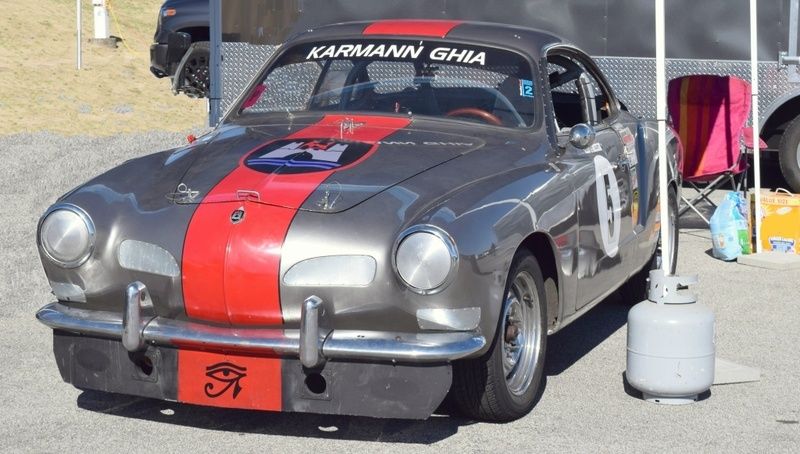
Hi TJ530,
Yes, our final field test is Daytona, 10-13 November. where we'll be able to reach and sustain high speeds for extended periods of time. We don't forsee any problems unless there are vibrational harmonics in the fan housing we havn't experienced before.
The engine will be in our Historic Sportscar Racing Karmann Ghia. Here's the link to the event.
http://hsrrace.com/events/2016_events/d ... rics-2016/
So far, we've been happy with the fan housing and our only extra prep for it at Daytona is cold air ducting for the fan intake from the Ghia's cabin through a firewall baffle.
FJC
-
TJ530
- Posts: 48
- Joined: Wed Aug 29, 2012 11:21 am
Re: CENTERMOUNT FAN SHROUD DUCTING INSERT
So assuming that everything works out well what's a rough production timeline look like? I've got a turbo engine build that's begging for that shroud. Any pics of the ducting that you are willing to share?
- GoMopar440
- Posts: 258
- Joined: Sun Apr 12, 2015 8:56 am
Re: CENTERMOUNT FAN SHROUD DUCTING INSERT
Glad to hear the R&D is progressing nicely. I'm still keeping an eye on this thread even though my rail project has been put on hold for a while. I hope to get it on the road by next summer if all goes well. If all goes well I hope to have one of these inserts on it by then. 
Home made rail (street legal), 1600 DP, 34PICT-3, T3 brakes, 4-1 glass-pack exhaust, 31's in back and 7.00x15's up front. Link to build thread: viewtopic.php?f=28&t=147561&p=1227553#p1227553
-
marce1967
- Posts: 2
- Joined: Sun Jan 22, 2012 8:32 am
Re: CENTERMOUNT FAN SHROUD DUCTING INSERT
Hi was wondering about the shroud insert, are you planning on selling any? I got one of those andays may be interested in getting one
- FJCamper
- Moderator
- Posts: 2910
- Joined: Wed Nov 14, 2007 2:19 pm
Re: CENTERMOUNT FAN SHROUD DUCTING INSERT
Gentlemen,
The insert is digitized into a CnC program and a prototype is on the test engine right now. We have been rescheduled from Daytona in mid-November to Sebring December 1st-4th.
A question for us at the moment is the exact best place for the throttle cable tube, as it touches the edge of one of the directional vanes right now. This was human error drilling on the prototype.
We do expect to sell these. Not many people will need them, but they will be available and affordable.
FJC
The insert is digitized into a CnC program and a prototype is on the test engine right now. We have been rescheduled from Daytona in mid-November to Sebring December 1st-4th.
A question for us at the moment is the exact best place for the throttle cable tube, as it touches the edge of one of the directional vanes right now. This was human error drilling on the prototype.
We do expect to sell these. Not many people will need them, but they will be available and affordable.
FJC
- FJCamper
- Moderator
- Posts: 2910
- Joined: Wed Nov 14, 2007 2:19 pm
Re: CENTERMOUNT FAN SHROUD DUCTING INSERT

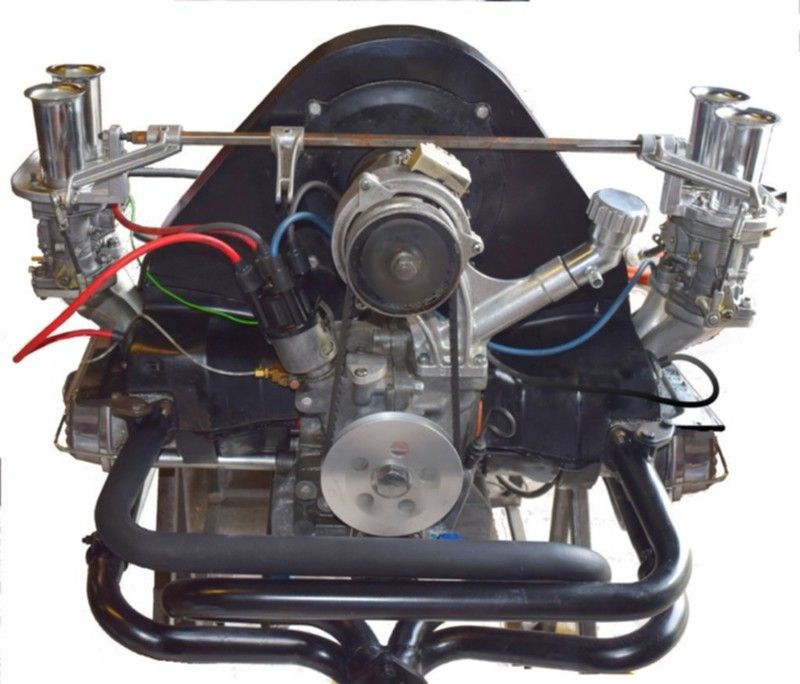
The centermount fan housing is popular because it allows more carb access space between the housing and the carb, and it looks purposeful, it's shape related to the original Type 547 blower on the 1950's era Porsche Spyders.
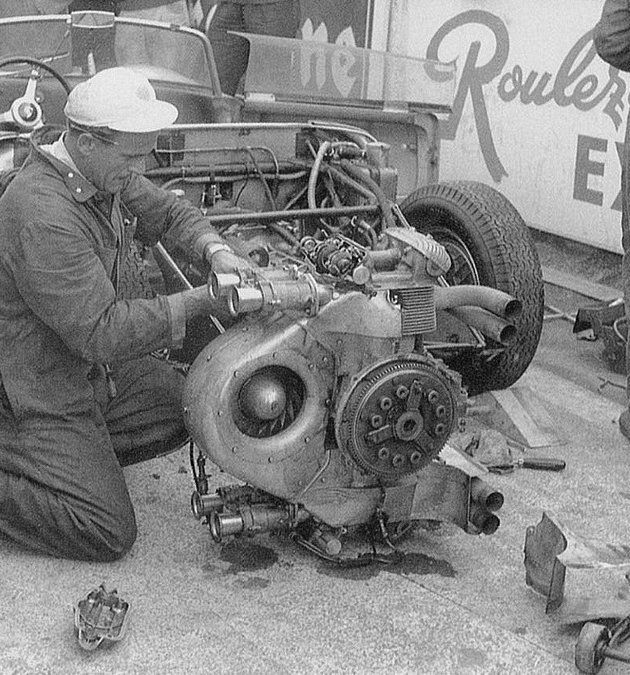
We began this fan housing project a couple of years ago, in hope of making the "centermount fan housing" cool more efficiently. According to the ad claims on the websites that sell them, the absolutely hollow (no baffels or vanes) housings distribute equal air flow.
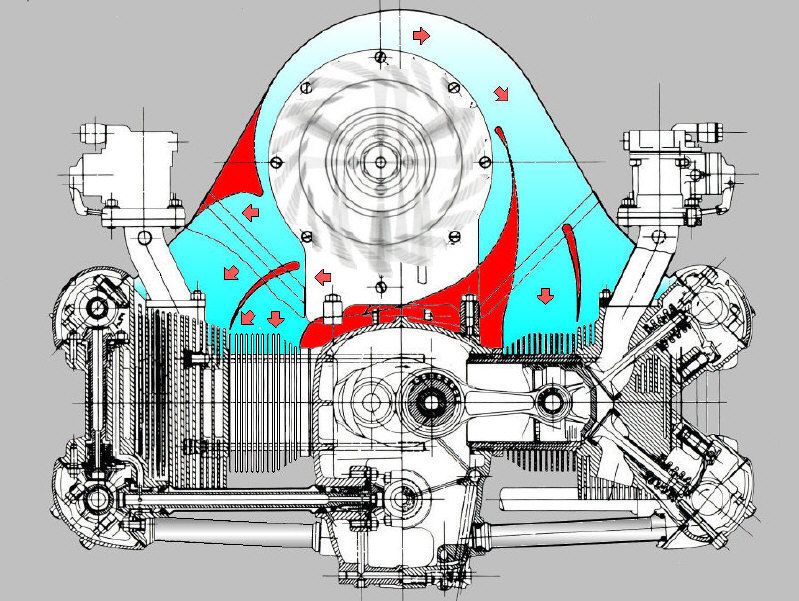
But they don't. One of our staff is a retired NASA-project engineer who specialized in flow dynamics, liquid and gaseous. He dismissed the equal air flow claim with no more than a short physical inspection. Facing the engine from the rear of the car, the fan turns to the right and the blades direct forced airflow to the right and up.
That means cylinders 1 and 2 get plenty of air, but on the cylinders 3 and 4 side there is a storm of turbulance as the forced air strikes the inside top of the fan and is forced downwards against what air manages to swirl around clockwise with the fan and tries to escape to the left. In short, the centermount housing, as sold, would produce less efficient cooling than a 36hp housing and significantly less than a doghouse type.
We saw immediately some stratigecially placed vanes and plenum chamber shapes would fix this problem. To be clear, our aspirations were to get at least as much cooling out of the centermount housing as a common doghouse might deliver. No miracle claims. Just good cooling combined with the assets of the centermount housing.
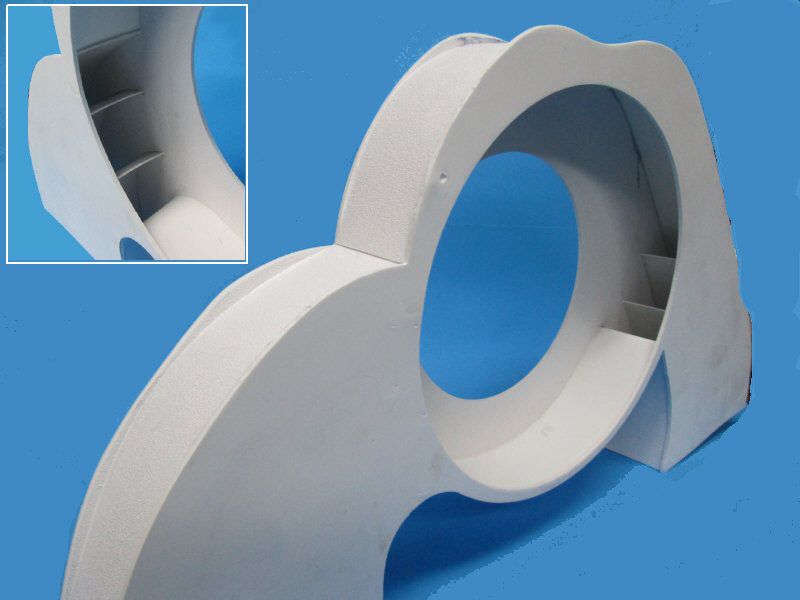
We chose the Porsche Type 547 engine's blower housing as our model. The 547 actually contained two fans in tandem, and had air intakes for them on both sides of the housing.
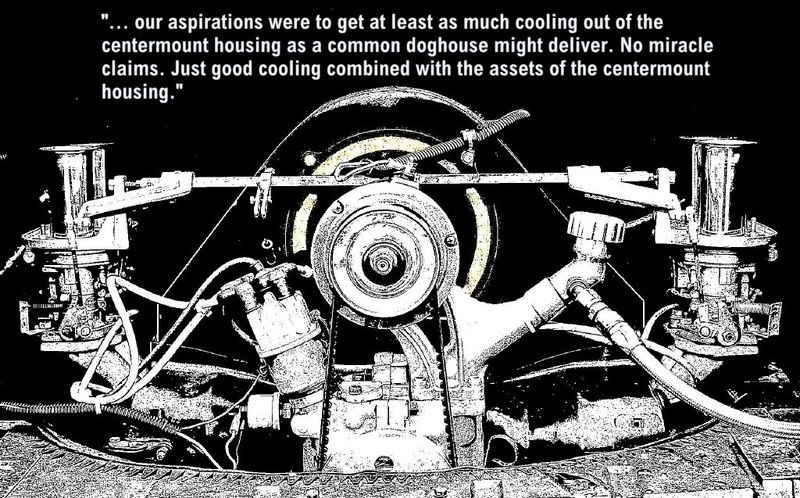
Our test track was Sebring Florida, a warm 80 degree F. even with December on us. The weather was dry, winds were light, and clouds were thin to nonexistent. Getting the insert to the track was the last step before being ready to market it. And the test went fine. No overheating, no vibration, no whine or whistling.
Head and oil temps, which vary for all of us, stayed within our normal range.
The insert is a success.

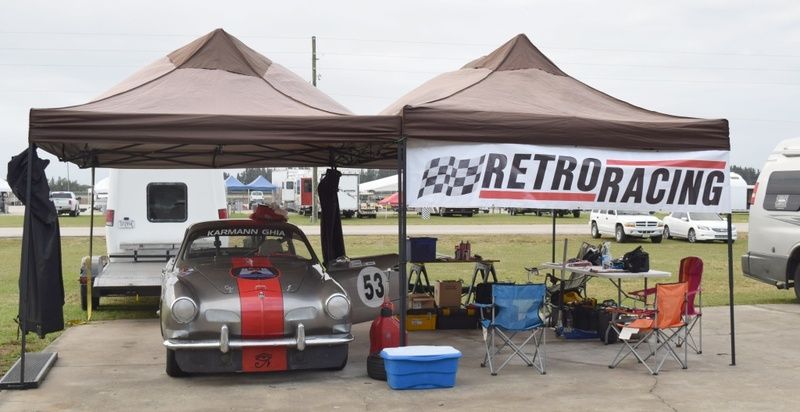
The End
- JiI
- Posts: 82
- Joined: Sat Sep 10, 2005 12:19 pm
Re: CENTERMOUNT FAN SHROUD DUCTING INSERT
Okay, now what is it going to cost the lowly VW builder on a budget? (i.e. ME!)
Jeff
Jeff
- FJCamper
- Moderator
- Posts: 2910
- Joined: Wed Nov 14, 2007 2:19 pm
Re: CENTERMOUNT FAN SHROUD DUCTING INSERT
Hi Jeff,
I'm talking with the manufacturer now. Prices shortly. It will be affordable.
FJC
I'm talking with the manufacturer now. Prices shortly. It will be affordable.
FJC
- JiI
- Posts: 82
- Joined: Sat Sep 10, 2005 12:19 pm
Re: CENTERMOUNT FAN SHROUD DUCTING INSERT
Are we talking Moore parts affordable or Jake raby affordable?
- FJCamper
- Moderator
- Posts: 2910
- Joined: Wed Nov 14, 2007 2:19 pm
Re: CENTERMOUNT FAN SHROUD DUCTING INSERT
Low end.
FJC
FJC
-
dragvw2180
- Posts: 287
- Joined: Mon Jul 17, 2006 12:01 pm
Re: CENTERMOUNT FAN SHROUD DUCTING INSERT
When you do get the pricing up I am interested in 4 , one for center mount and three for 36 fan shrouds for my turbo engines. Mike McCarthy
- JiI
- Posts: 82
- Joined: Sat Sep 10, 2005 12:19 pm
Re: CENTERMOUNT FAN SHROUD DUCTING INSERT
I'll want one for my volksrod.
Jeff
Jeff
-
H2OSB
Re: CENTERMOUNT FAN SHROUD DUCTING INSERT
Any update on pricing Mr Camper? I've found a center mount fan housing meant for a T4 upright conversion. This might be just the thing.
H2OSB
H2OSB